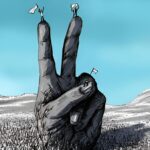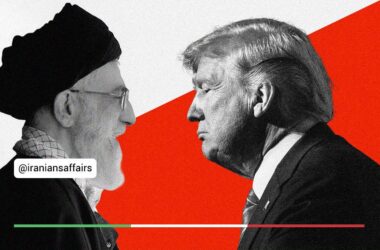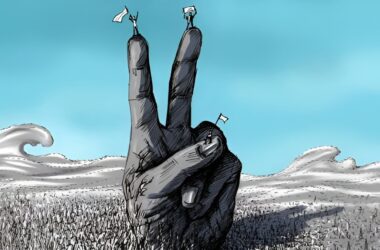The deployment of U.S. strategic B-52 bombers in the region, particularly under current conditions, signifies a substantial shift in regional dynamics. This action, following recent Israeli strikes on the Islamic Republic’s military facilities and the destruction of the regime’s air defenses, along with reciprocal threats from the Islamic Revolutionary Guard Corps (IRGC), carries significant messages for both regional and international actors.
The latest American maneuvers in the Middle East come at a time when the Islamic Republic is grappling with a complex array of internal and international strategic challenges, giving these movements heightened significance. Although the U.S. has previously bolstered its military presence in the region, today’s context differs starkly. Proxy forces of the Islamic Republic, such as Hezbollah and Hamas, were once at their peak strength, enjoying full backing from the regime to conduct their activities. However, Hamas is now at its weakest point, facing near-collapse after military and political operations led by Israel. Hezbollah fares no better; Israel’s precise and effective operations have drained much of its strength. Simultaneously, the Islamic Republic’s allied fronts in Syria, Yemen, and Iraq are also experiencing declines in their military and economic capacities.
Moreover, the Islamic Republic’s military approach of leveraging its missile capabilities as a deterrent has evolved in recent years. Unlike the past, when missiles were primarily used as a threat, the regime has carried out two strikes on Israel and one on Pakistan this year. These attacks have not only exposed the regime’s strategies but have also heightened security concerns in the region, making Western allies more alert to these threats.
Meanwhile, the domestic situation in the Islamic Republic has deteriorated into a profound crisis. Over the past eight years, the regime’s legitimacy has significantly waned due to relentless economic pressure, widespread social discontent, and severe political repression, reaching its lowest point. In recent years, this issue has become a critical challenge for the Islamic Republic, severely restricting its internal and strategic maneuverability. Additionally, from an international perspective, the regime has faced deepening isolation, losing much of its ability to exploit global divisions to maintain its influence.
The domestic and international issues faced by Russia and China—long-time supporters of the Islamic Republic—have further impacted the regime’s ability to garner international backing. In recent years, Russia has been mired in numerous conflicts and crises, including the war in Ukraine and severe Western economic sanctions. These challenges have strained the Kremlin, leaving it with fewer resources and less capacity to offer effective support to the Islamic Republic. The economic and military pressures on Russia have forced it to prioritize its own national interests and security, significantly reducing the extent of military and economic cooperation with the regime, to the point of seeking assistance from North Korea.
China is also grappling with considerable internal and international challenges. The country’s economic growth has slowed in recent years, with economic problems such as the real estate crisis, rising domestic debt, and declining GDP growth exerting pressure on Beijing. Additionally, political and economic tensions with the United States and Western allies, stemming from geopolitical rivalries in the Pacific region and trade disputes, have exacerbated China’s challenges. As a result, China, despite maintaining economic ties with the Islamic Republic, has become more cautious in extending its military and political support, focusing instead on domestic issues and strengthening its position in East Asia.
Under these circumstances, the Islamic Republic must rely more heavily on its internal resources and limited regional capacities. Furthermore, doubts about Iran’s missile and air defense capabilities have intensified. Israel’s allied countries have taken greater precautions to counter the regime’s missile threats, bolstering their defense systems and reducing their vulnerabilities.
The threat posed by the Islamic Republic’s nuclear program has also reached its peak, with all evidence suggesting that the regime may be moving toward the final phase of producing a nuclear bomb. However, it should not be overlooked that Iran’s military and air defense weaknesses, combined with its internal economic and social challenges, have diminished its ability to respond to external threats. In such a scenario, the extensive U.S. military presence in the region serves as a serious warning, delivering a stronger message to Tehran and significantly raising the likelihood of reciprocal actions.
Over the past year, the U.S. has managed to deter the Islamic Republic from aggressive actions by deploying forces and military assets in the region. After Hamas’s attacks on Israel on October 7th and the subsequent escalation of tensions in the Middle East, the Pentagon quickly dispatched two aircraft carrier groups to the area and increased the number of fighter jets to demonstrate its resolve against Hezbollah and the Islamic Republic. These measures clearly underscored America’s commitment to supporting Israel and deterring threats. Moreover, after the Islamic Republic launched over 300 missiles and drones at Israel in March 2024, U.S. forces played a crucial role in defending Israel, intercepting dozens of Iranian drones and ballistic missiles. Additionally, following the assassination of Ismail Haniyeh in Tehran, U.S. military presence once again proved effective and successful in restraining the regime.
Faced with recent shifts and diminishing international support from Russia and China, as well as a lack of domestic legitimacy, the Islamic Republic might resort to offensive measures instead of a defensive stance to mitigate mounting pressures. This approach could involve missile strikes on regional targets or bolstering proxy groups in Iraq and Yemen to alter regional security dynamics. Such moves could be prompted by Israel’s powerful strikes against the regime’s air defenses, a blow that the Islamic Republic cannot easily dismiss and might feel compelled to respond to in order to preserve its image. Additionally, this approach could reflect Ali Khamenei’s deeper understanding of Israel’s long-term objectives to weaken the regime. Israel’s recent attacks appear to be the first in a series of sustained and direct responses, and it seems that Khamenei has recognized this pattern, opting to act preemptively rather than await further assaults.
However, adopting an offensive strategy carries the risk of escalating conflicts and even triggering a full-scale war, which would entail heavy costs for the Islamic Republic. The presence of U.S. military forces in the region, including B-52 bombers and aircraft carriers, signals America’s readiness to deliver a decisive response to any hostile act. The Islamic Republic finds itself cornered, and it remains to be seen whether it can find a way out of this predicament or if “this time, it really is different!”







